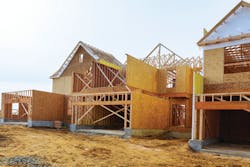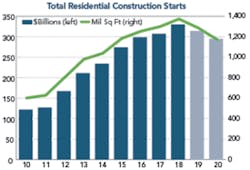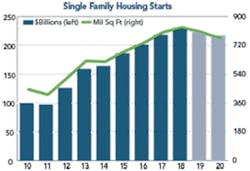First, the good news. 2019 was another solid year and most contractors from almost all segments of the industry hit their revenue goals and then some.
The AHR Expo 2020 Economic + Industry Report, which surveyed 1,418 attendee and exhibitor respondents, asked them how 2018 projections compared to the actual results of 2019. 70 percent reported at least 10 percent growth, while 34 percent reported significantly more than 10 percent growth.
And most respondents were optimistic about business in 2020, with 79 percent reporting their prospects to be good or excellent; with 75 percent expecting business to increase; and with 25 percent expecting business to increase more than 10 percent.
According to the Dodge Construction Outlook for 2020, 2019 saw a robust labor market that boosted consumer spending. The first three months of the year saw a boost in inventory accumulation as businesses ordered more goods to use in the future, which gave a jolt to the country’s GDP. While that “sugar high” faded by the second quarter as GDP growth slowed to 2.0 percent, consumer spending accelerated and government spending increased due to an uptick in non-defense spending.
Of particular interest to the construction market, October of 2019 saw the Federal Reserve cut interest rates for the third time that year. According to a release by the Marcum Commercial Construction Index, “Faced with surprisingly low inflation in the context of weakening global economy and a still sturdy U.S. dollar, the Federal Reserve has seen fit to put downward pressure on borrowing costs,” all of which is good for developers and borrowers alike.
The strong year just past, not to mention the entire decade of expansion the U.S. economy has seen, means that most contractors—small, mid-size and large—have been able to book work and build backlogs that will see them busy well into 2020. Most mid-to-large-sized residential plumbing companies have, in the last decade, put an emphasis on maintenance and service contracts which gives them a revenue “cushion” when times are bad and “springboard” when times are good.
Uponor is the largest PEX pipe and fittings supplier to the North American market. The company had its start in the 1980s with the in-floor radiant market, transitioned into residential plumbing and has, since the mid-2000s, seen most of its growth in the commercial plumbing space. Having progressed through those verticals, they are uniquely positioned to comprehend the state of the current construction market, especially as it applies to plumbing and heating sub-contractors.
And when it comes to 2020, “We’re fairly optimistic,” says Bill Gray, President of Uponor North America. “We’re very well positioned for the expected moderate growth and opportunity. So I’m relatively optimistic about the outlook for 2020, both on the manufacturing side as an employer, and on the sales and distribution side as a supplier to the construction market.”
And Now the Bad News
Even the best parties have to end sometime. According to Dodge Data and Analytics, total construction starts are now tipping over the edge into decline. Total starts reached a peak at $815 billion in 2018 and will inch down 1 percent to $809 billion in 2019. Dodge expects total construction starts to decline a further 4 percent in 2020 to $776 billion.
· Single family housing starts peaked in 2018 at 833,000 units ($230 billion), then headed 3 percent downward in 2019 and will drop another 5 percent in 2020 to a cyclical low of 765,000 units.
· Multifamily housing starts reached a peak in 2018 at 542,000 units ($99.8 billion) and will drop 11 percent in 2019 and 15 percent in 2020 as starts fall to 410,000 units. In dollar terms, multifamily starts will slide 9 percent in 2019 followed by a 13 percent drop in 2020 to $78 billion.
· Commercial building starts are expected to peak in 2019 at $127 billion (although square footage peaked in 2017 at 770 million sq. ft.). In 2020, starts will slide a more pronounced 10 percent to 670 msf, and dollar value will fall 6 percent to $120 billion.
Some of the factors that are weighing down the construction market include the skilled labor shortage, the price of materials, the price of land and the regulatory environment.
According to the U.S. Bureau of Labor Statistics’ Job Openings and Labor Turnover (JOLT) survey, the construction industry was associated with 379,000 unfilled positions in August of 2019, the highest level recorded in the 19-year history of the data series. According to Associated Builders and Contractors’ Construction Confidence Indicator, more than 59 percent of surveyed contractors intend to increase staffing levels during the six-months between 2019’s final quarter and the end of 2020’s first.With 4.8 percent of all construction positions unfilled (also an all-time high) the lack of available workers will, inevitably, put upward pressure on labor costs. The producer price for construction costs has risen more than 5 percent in the Midwest, West and Northeast over the past year (according to data from Marcum Commercial), in part because many contractors are paying significant overtime.
When it comes to materials, while the price of lumber has been historically low, prices for steel, gypsum and glass have increased rapidly. Complicating the entire equation is the ongoing trade wars with China, the re-negotiation of NAFTA as the USMCA, and possible tariffs against goods from the EU and South America.
“The worst thing you can have as a business leader is unpredictability,” says Bill Gray, “whether it’s in the manufacturing or the homebuilding space. You need consistency to know whether your investment is going to pay out.” And the current trade environment has been historically unpredictable.
Federal, state and local regulations also lend an element of unpredictability to any contractor or builder trying to plan out the coming year.
And another constraint on the construction market that seldom gets discussed is the high price of land for development. “We have to understand,” says Bill Gray, “availability of land for conversion and the increased time it takes for permitting and all those kind of things will be challenges… in the places where people want to live land is expensive. In California and some of the southern states land affordability has become a huge issue.”
A New and Different Market
In a very real sense, builders, developers and contractors face an economic and demographic environment very different from anything in recent experience. Many economists speak of a “Lost Decade,” where young people graduating from college were too burdened by student debt to even consider buying or financing a home. Now that the Great Depression is more than a decade past, is there a potential untapped market in the wings? Waiting, perhaps, for the next economic downturn as a buying opportunity?
And of course, that downturn is somewhere out there in the future. What goes up, after all, must come down, and after a decade of unprecedented economic growth, the next recession—be it great or small—is as certain as it is unpredictable in its timing, scope and severity.
Another demographic influence is the cresting wave of the Baby Boomers. The Boomers have embraced aging in place, staying in their homes as long as possible. But now the forward cadre of the Boomers are moving into assisted living or passing away and their homes are coming on to the market.
“The Boomers with this new housing coming on at the same time won’t get their pricing expectations,” says Bill Gray, “so you’re going to have some interesting dynamics happening there.”
But whatever the shape of the market to come, those contractors who are able to embrace new technology (especially digitalization, such as BIM, and prefabrication) will see the productivity gains they need to achieve in order to succeed.
“Productivity won’t just be nice to have,” says Bill Gray. “In order to compete and hit job schedules, owner requirements, it won’t just be an option any more… There will be the leaders of the industry who will embrace those things first—this always happens—and then it will permeate to other layers of the construction space.”
Those changes have been faster coming to industries such as manufacturing, which have controlled environments and repeatable processes, but they are coming—at last, inevitably—to the construction trades. And perhaps that will be the biggest change we see in 2020.
About the Author
Steve Spaulding
Editor-in-Chief - CONTRACTOR
Steve Spaulding is Editor-in-Chief for CONTRACTOR Magazine. He has been with the magazine since 1996, and has contributed to Radiant Living, NATE Magazine, and other Endeavor Media properties.


